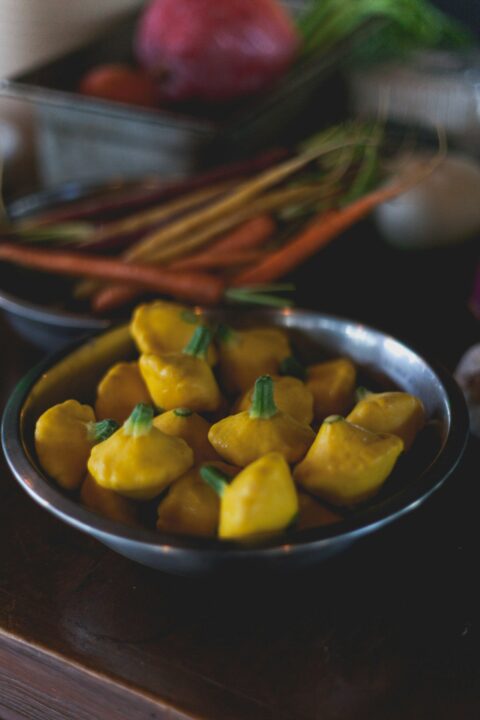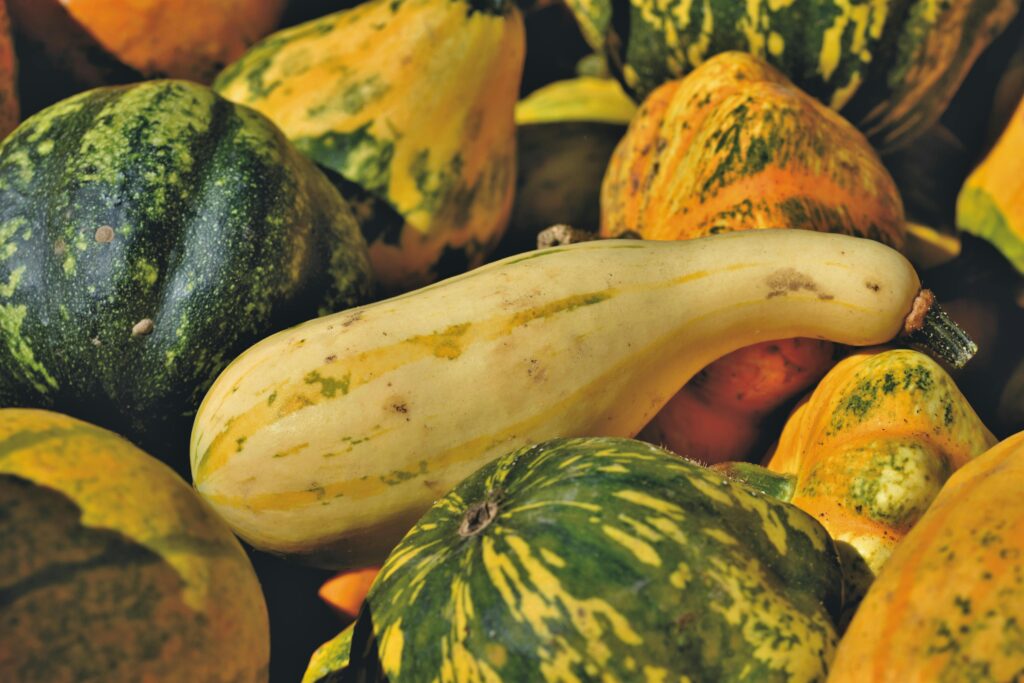Who doesn’t love squash?! You can mash, purée, stuff, or slice it. However, there are numerous varieties available and determining how to effectively use them in the kitchen can be intimidating.
After carrying out in-depth research on the types of squash, here’s a complete overview of some of the most popular and versatile types of squash
Types of Squash (Winter)
1. Spaghetti squash

Perhaps the most popular of all types of squash, spaghetti squash contains shredded flesh that resembles, you got it, spaghetti. That is why it is frequently used as a healthy, low-carb substitute for spaghetti. It’s also ideal for stuffing thanks to its spacious interior.
2. Butternut Squash

This squash is often shaped like a bulb and has a tan exterior color. This winter squash’s distinctive sweet flavor and rich texture make it a popular ingredient in cold-weather meals like soups, risotto, and gnocchi. It is also extremely adaptable and can be simply roasted or sautéed to bring out its distinct flavor.
3. Acorn Squash
The acorn squash is green on the outside and yellow-orange on the inside, just like its name implies. It has a moderate flavor and is ideal for roasting or stuffing. Simply scoop out the seeds and coat the interior flesh with syrup or brown butter to make the perfect roasted acorn squash.
4. Delicata squash
Delicata, an heirloom variety, has a cream and green striped rind. This oblong squash is highly soft and tastes similar to a sweet potato. The skin of a delicata squash is edible since it is very thin. They taste great baked or stuffed and the seeds can even be roasted for a salty fall snack!
5. Kabocha squash
This Japanese squash is squat in shape, with a green rind and orange flesh. The firm flesh and sweet flavor make it ideal for mashing and utilizing in baked products. It is also widely used in soups and is largely grown and consumed in Japan, South Korea, Thailandand the United States.
6. Sweet Dumpling Squash

Sweet dumpling squash is significantly smaller than other winter squash cultivars. It’s around the size of a large apple and looks like a little pumpkin with a multicolored rind.
Because of its size and form, this squash is sometimes carved out and used as a soup bowl or stuffed with meats, grains, cheeses and vegetables.
The flavor is comparable to sweet potatoes, and the flesh is smooth and delicate. Try using sweet dumpling squash instead of acorn squash in your recipes.
7. Sugar pumpkin
This vivid orange gourd is a fall favorite, but it serves more than just a decorative purpose. The sugar pumpkin is most commonly used to make pumpkin pie, but it also works well in breads, muffins, cupcakes and soup.
8. Red Kuri Squash
This squash, also known as an orange Hokkaido pumpkin, has a teardrop form and orange skin that is edible when cooked. Its flesh is silky and yellow, with a chestnut flavor. The word “kuri” is Japanese for chestnut.
Red kuri squash, like sweet dumpling squash, can be used as an acorn squash alternative. Try stuffing it with rice, veggies, beans or meat.
9. Carnival Squash
This beautiful, multi-colored squash is a hybrid between acorn and sweet dumpling squash and may be readily swapped for either. The flesh is delicious and ideal for stuffing, baking, or soup.
10. Buttercup Squash
Buttercup squash, unlike butternut squash, looks like kabocha and has orange flesh that dries out after cooking. The skin of this squash must be peeled because it is unfit for consumption. It’s great roasted as a side dish, baked into a casserole, stuffed, or mashed into soup.
11. Hubbard squash
This huge squash, which weighs between five and fifteen pounds, has a slate-toned color and a bumpy surface. But don’t be fooled by its appearance; this squash has a sweet flesh that can be utilized instead of a pumpkin. The texture is gritty, so it works best when mashed or pureed.
12. Banana Squash
Like its namesake, this squash has a bright yellow shell and a long form. Its flesh is orange and sweet, making it ideal for mashed or pureed soups. It can also be used as a salad garnish by shaving thin slices of the flesh.
Types of Squash (Summer)
While yellow squash and zucchini squash are commonly found in grocery stores throughout the year, summer offers new squash species. The primary distinction between summer and winter squash is their duration on the vine.
Summer squash is picked significantly earlier than winter squash, resulting in a soft and fragile surface. Summer squash is best diced and sautéed, and it takes less time to cook than winter squash.
Remember that summer squash should be chilled and consumed within a week or two of purchase (unlike hard winter squash).
13. Yellow Squash
Yellow squash features bright yellow skin with a bulbous bottom that tapers to the top. It is frequently used alternately or in combination with zucchini (like peas in a pod).
Yellow squash is classified into two types based only on its neck shape: straight neck and crookneck. They have thin, soft skins that make them ideal for chopping, sautéing, or baking in casseroles.
14. Zucchini squash

Zucchini is the most popular squash during the summer and with good reason. This multipurpose vegetable has a dark green hue and a straight shape. Zucchini absorbs the flavors of the spices it is cooked with, making it ideal for grilling, sautéing, steaming, baking and other cooking methods.
It also makes an excellent low-carb substitute for fries or noodles. And, of course, zucchini is ideal for baking. You can make almost anything with zucchini, from classic Zucchini Bread to cookies.
15. Patty Pan Squash

This summer squash is shaped like a spaceship and comes in white, yellow and green (or a combination of the three). This odd squash is not as common in grocery stores as yellow squash or zucchini, but it is frequently found at local farmer’s markets. This is another multipurpose squash. It’s delicious steamed, sautéed, fried, grilled, baked, and stuffed.
16. Chayote Squash.
Although this squash resembles a pear, you should generally avoid biting into it directly. Chayote squash originated in Mexico and is currently grown throughout the world.
This squash is incredibly low in calories and has a cucumber-like flavor. It, like other summer squash, is incredibly adaptable, with options for grilling, sautéing, baking and soup. You can even eat it raw as a salad topping for an extra crunch.
Is squash a fruit or a vegetable?
Most squashes have a mellow, nutty flavor and a smooth texture. As a result, they are typically handled as vegetables in cooking. However, squash is considered a fruit.
This is because it contains seeds and is derived from the flowering stage of plants. Cucumbers, eggplants and tomatoes are examples of “fruits” classified as vegetables.
Now that we’ve established that, continue reading for a list of sixteen common winter and summer squash varieties, as well as simple recipes for using them.
What’s the distinction between winter and summer squash?
Winter squash, including butternut, spaghetti, acorn and pumpkins, have hard, thick skins, sweet, dense flesh and ripe seeds, making them great for roasting, mashing and soups. Summer squash, such as courgettes and patty pan, features soft, edible skins, edible blossoms and milder-flavored flesh. They are best suited for barbecuing, grilling, frying, or adding raw to salad.
What to look for when buying squash?
When choosing squash, look for ones that are firm, weighty for their size, and free of blemishes or bruises. The skin should be matte, not shiny, indicating ripeness.
What is the best method for cooking squash?
-
Roasting
Both winter and summer types of squash can be roasted, however, winter squash requires more time to cook.
To roast, prepare your squash as needed, either peeled pieces or wedges, put in oil and any additional flavorings you desire, then roast at 200C/180C fan/gas 6 for around 20 minutes for summer squash and 30–40 minutes for winter squash, or until soft and browned around the edges. Butternut squash can be halved, seeded, filled and roasted.
Toss thick slices or halves in a little oil and grill or griddle for 5–6 minutes on each side, or until charred and softened.
-
Raw
Courgettes can be eaten raw, although they are best thinly sliced or peeled into ribbons and seasoned with salt to soften before dressing and using in salads.
How to store squash
Store squash in a cool, dry area out of direct sunlight. Winter squash can be stored for months, whereas summer squash is best consumed within a week or two. Cut portions should be stored in the refrigerator and used within a few days.



